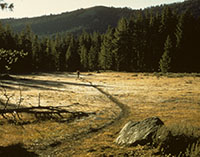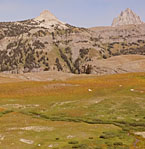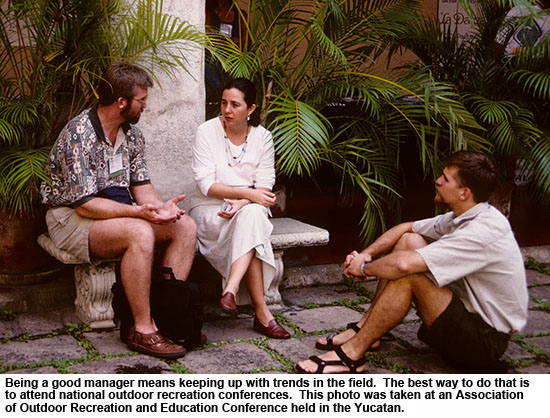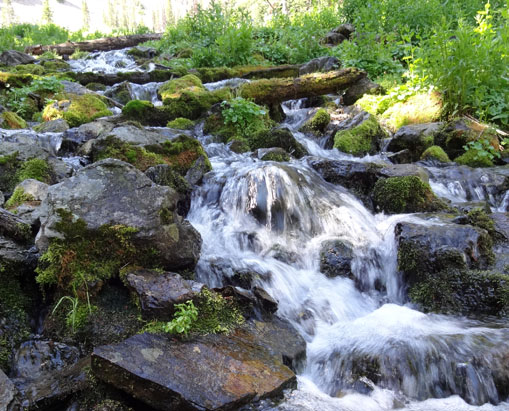Copyright & Revisions: Original copyright © 1992. Revised in 1998. Reformatted in 2013. No changes made to 1998 text.
Publication History: This paper was first published under the title of "Management and Administration of Outdoor Programs" in Adventure Education by John Miles and Simon Priest (eds.), Venture Publishing, 1990. It was published again in slightly altered form under the title of "Some Observations on the Management of Outdoor Programs" in the Proceedings of the 1991 International Conference on Outdoor Recreation, Craig Rademacher and Ron Watters (Eds), Idaho State University Press, Pocatello, 1992. The paper reproduced here was revised in 1998 for a new edition of Adventure Education.
Reproduction Information: You are welcome to provide links to this page or to use short quotations and paraphrases in other documents as long as they appropriately reference the source. There is no charge for non-profit organizations to reproduce or publish extensive parts or all of this paper, but please obtain advanced permission from Ron Watters (wattron@isu.edu). Photo credits: Ron Watters.
IntroductionSince the heady, hectic days of outdoor programming in the mid to latter part of the 1900s, a slow, maturing process has settled upon the field. The field is still young, of course, and full of promise for meaningful experiences for participants and stimulating job opportunities for professionals. But the field has come to a point where most program directors find themselves wearing the hat of an administrator more than that of an outdoor educator.
It's not because those of us the in the position dreamed of shuffling papers. Rather, it is a necessity brought on upon the changing nature of outdoor education and society. Outdoor employees are seeking reasonable salaries and benefit packages. Participants want quality instruction and services. Upper level administrators ask for travel requisitions, risk management plans, and written justifications of program. And the legal profession continues to cast its menacing shadow over programs.
All of these and more require our attention in an administrative and managerial capacity. And, like any form of management, the style utilized is dictated by the service or product provided. In our case, the service is outdoor recreation, and there are management procedures and techniques particular to the field which are helpful in running outdoor operations. I won't attempt to cover the entire topic in the limited space this paper, but I will touch on a few key areas that I've found helpful in my 25 years in the field. One of those areas is the most vexing, yet rewarding parts of outdoor management: personnel.
Personnel ManagementThe nice thing about outdoor education is that it attracts good people, willing to devote inordinate amounts of their time and energy. Certainly, there are a few misguided souls who would be better off in more sedentary positions. But on the whole, it has been my experience that finding the right people is not the problem. Rather, the challenge of personnel management in outdoor programs is dealing with the over-enthusiastic and eventually over-worked employee.
Outdoor Program jobs are far different than the typical working situation of 8 to 5. A staff member might work a full weekend on a backpack trip, then be back in the office on Monday morning . . . and then work several evenings teaching kayaking during the week . . and then work the next weekend. It's not unusual during height of ski or summer seasons for a employee to work 4 or 5 weeks without a break.
Upon hearing about such work hours, the standard layman's impression is "well, it's easy work. He's just out playing". Certainly it's play, but it's other people's play. And that is the catch. There's a big difference between personal recreation and recreation which is done for the benefit of others. Even in the least structured of all styles of outdoor trips, the common adventure trip, outdoor program staff are burden with the responsibility of helping guide democratic process within groups. Democracy even within small groups is never easy, and dealing with personality conflicts within the unsettling environment of the outdoors can be and is wearing. When you're doing it every weekend, it's work.
What is at the heart of the matter is an emotional commitment to the job and the participants. Some trips go smoothly, of course. But others are different. Like a raft with a slow leak, an outdoor staff person staggers home at the end of emotionally demanding trips, flaccid and deflated. Often the next morning they'll be back the office, cleaning up the van, putting away gear and tying up the loose ends. Throw several of these trips together, and with time, burn-out enters the picture and quietly does its damage.
The cure, of course, is time off. Outdoor Program directors need to keep an eye on how much their staff is working and watch for the signs of burn-out. A little time off to enjoy one's own personal recreation or do something different can greatly improve employees' outlook and productivity.
The method in which time off is given will depend upon the appropriate protocol of the sponsoring institution. In my situation, for years we were able to provide time off on an informal basis. The idea was if you worked a weekend you took two days off. Stricter state requirements now require us to record compensation (comp) hours. It is difficult to calculate the number of hours outdoor program employees work when they're on trips, but generally giving 8 hours compensation for each extra day beyond a regular 5 day week is accepted as fair. For instance, a person working a weekend trip receives 16 hours of comp time (8 for Saturday and 8 for Sunday). This method requires greater paperwork, but from procedural standpoint most personnel departments will be more comfortable with it than informal methods.
A number of Outdoor Program directors and employees have indicated to me that they are unable to accumulate compensation hours. However, in Idaho, where I work, the state has determined that compensation hours should be granted to those in outdoor work (including Conservation Officers working for the Fish and Game Department) in order to be in compliance with the Fair Labor Standards Act. If you are not presently on the comp hour system, then it may be wise to check with your personnel department. According to the act, certain positions, occupations and trades are exempt from the comp hours provisions of the law. A review of those exempt positions, however, do not include anything which would resemble an outdoor program job (U.S. Department of Labor, 1975).
It is very important that your superiors, the people who are above your program, understand the amount of time and emotional commitments being put in by your staff. I'll talk about communication with superiors later in the paper, but you need to make a concerted effort to remind those in authority of the good work and dedication put forth by your staff. With this understanding, your superiors can set the record straight to higher administers.
Program PlanningI don't want to state the obvious, since everyone's fully aware of it. But it won't hurt. Plan carefully. Assiduous planning is key to a smoothly functioning program. While there are various stratagems than can be employed, I found that two elements greatly assist the process. One is regular staff meetings and the other is a large calendar with lots of space to write down ideas. The regular staff meeting (once a week) is used to touch base with everyone, to find out how trips went and to generate ideas for upcoming events.
I would suggest scheduling the planning meeting early in the week, since the staff can make last minute preparations of activities occurring later that week. For specific days, Monday is OK, but Tuesday is better. Mondays are often poor days since staff members who have just worked the weekend come in the meeting are tired. Tuesday seems to be a much more energetic day, and staff members more enthusiastic and better inclined toward rolling up their sleeves.
The large planning calendar comes to meetings as well. As ideas are discussed, they are penciled in on the calendar. The calendar serves to remind staff members about events coming up, publicity that needs to go out, rooms to be scheduled, etc. By using pencil the calendar is easily altered and updated. When it comes time to print out schedules, the calendar serves as a convenient rough draft.
Volunteer ManagementFew in the outdoor program business have the luxury of working with liberal budgets. Often funding is tight and there's little to spare. Thus methods must be found to stretch hard earned funding dollars. The use of volunteers is one such method.
Volunteers can serve many functions in an outdoor program. They can help organize and take out trips, run workshops, conduct evening programs, help with disabled programs or even assist with office duties. Those with programs at universities have a advantage here. The student population on a college campus serves as a great pool from which young, enthusiastic volunteers can be drawn.
But volunteers don't necessary always need to be young or come from the campus. Volunteer resources are available in any community. Take evening programs, for instance. A good many emergency room doctors are more than happy to do sessions on emergency first aid procedures in the backcountry. A geologist might be interested in doing a program on the geology of a popular climbing area. A member of nearby ski patrol likely could be talked into doing a program on avalanche safety. Even the local insurance agent might turn out to be a good prospect for a program, particularly one who has just returned from a trek to Annapurna. It a pleasant marriage. Volunteers are happy to do their program and share their knowledge and skills and you're happy to have the free offering.
Some volunteers require extra time, particularly those that will be assuming coordinating or leadership positions in the program. Many programs have found the extra time spent training to be well worth the effort. The University of California, San Francisco is an example of a program that provides training for volunteer coordinators in its successful common adventurer trip program. Handicapped programs throughout the country provide training programs and utilize volunteers extensively in such programs as skiing, rafting, sailing, horse riding, etc.
Before unleashing denizens of volunteers, let me issue a warning. Volunteers are not a cure-all. Many prospective volunteers are initially enthusiastic, but when the routine work begins they suddenly disappear. Others are simply unreliable. It takes work to interest the right people, and once the right people are found, it takes more work to cultivate and keep them motivated. Show personal interest in volunteers. Follow up good helpers with phone calls. Invite volunteers to social events, like a pizza evening after a day of ski touring, or the annual Christmas Party at the end of the year.
People who volunteer do so not only for the personal satisfaction of helping others. There are other reasons, and often times, it is the other reasons that are most important. They may have a need to be a part of a group. They may get an ego boast from being in leadership position. Or they may enjoy the extra recognition and prestige that comes from leading. It is an understanding of these other motivations which can help you keep volunteers on track and enthusiastic.
One tenet of volunteer management is to always give recognition. Don't be afraid to be profuse. Making the extra effort to compliment and say thanks over and over will pay many dividends. If you keep that in mind, you'll have a windfall of volunteer help in your programs.
Program Record KeepingThere's little joy in it. Nobody looks forward to it, but directors of outdoor programs more than anyone need to keep good records--for good reason. Good record keeping shows a level of sophistication. By having data on participation, results of participation satisfaction surveys, or an analysis of costs and benefits, you are in a much better position to justify the expenditure of funds for your program. Program with no records or poorly tabulated participation figures appear, even though they might not be, loosely organized and poorly run.
Record keeping need not be taxing as long as it done on a regular basis. I utilize the weekly staff meeting as a time to keep records up to date. While the staff meeting is underway, a master data sheet can be passed around and members of the staff can update their entries for the past week. A variety of records can be kept, but at the very least, good participation records should be maintained. Even if your sponsoring agency or institution doesn't require one, prepare an annual report with total numbers of participants and information on the year's highlights.
The journal method is one way of collecting records and information as the year progresses. The journal, which is basically a scrap book, can include participation figures, copies of news releases, photographs from trips and complimentary letters from participants. At the end of the year, the annual report can be easily prepared by paging through the journal and picking out significant events. The journal, if left in a prominent place in the outdoor office, also serves as a good promotional tool. People stopping the office invariably pick it up and page through it.
Politics of Outdoor ProgrammingThe smoky, sultry world of politics is probably the last arena in which an outdoor program director wants to get involved. But the political arena described here is not the sultry kind, nor is it kind that involves the surreptitious jockeying and power positioning that some times takes place within the bureaucracy of institutions. Rather, this is about it's more subtle form: the wise, tactful and artful way of getting things done.
When you are in charge of an outdoor program, how tactful your approach often means the difference between good administrative support and poor administrative support. Or put more practically, it's the difference between a good budget and a poor budget.
Artful politics involves the understanding of power structures within institutions. One way of categorizing institutional power is to look at it from the perspective of two dimensions. (Banning & Sherman, 1988). One dimension is authoritarian power. Authoritarian power is that which is assigned by the institution. The power that your superior possesses to hire supervise you or to approve your budgets has been given to him or her by the institution. Most institutions have flow charts showing the network and chains of authoritarian power.
The other dimension of power, influential power, is not assigned by the institution. This the kind power which comes through personality, tact and persistence. It also comes through friendly contacts, respect for work and logical and compelling proposals. And if its carefully nurtured and used, influential power can effect positive change.
Outdoor Programs are always low on the authoritarian power scale. It's never more obvious than by looking at the institutional flow chart where the rectangular box housing the outdoor program appears at bottom of the page--if it appears at all. It is, then, influential power which must be utilized by outdoor program directors. The development and use of influence doesn't happen overnight. It takes time.
What is important is that you understand your institution's protocols and the chain of command in which you fit and who, in that chain, are the key people. Make friends with those above you. Keep it on a business level, but friendly. No one likes to deal with negative people. Keep supervisors, especially your immediate supervisor, informed of your program's activities. When supervisors hear from you on a regular basis, they become comfortable and stay comfortable with the your program. That's the way you want supervisors. If they are not familiar with the program, you'll have little support when chips are down.
Administrators higher in the chain of command are more difficult to reach. But, nevertheless, you should take advantage of occasional opportunities to make contact when they present themselves. If the community newspaper runs a complimentary article on your program, you may wish to send a higher administrator a copy of the article. Supervisors and presidents like good press--and good mail. When you have enthusiastic participant who just had a wonderful time on a trip, have them drop a line to the president.
Sometimes help comes from unexpected corners. Our program occasionally runs climbing demonstrations for high schools around the area. At one of the out of town demonstrations we learned that a teacher who helped organize the event was a state senator on a key legislative committee. When we found this out, we asked if he wouldn't mind dropping a line to our immediate supervisor and the president of the University. He didn't mind, and ended writing a complimentary missive on legislative letterhead.
A year later, I submitted a proposal for extra funding which was considered by the president of our university. The extra funds were sorely needed in our in our handicapped program. In the end, we were successful in obtaining the extra funds. Did the letter from the legislator help us? One can never be certain. There are many factors which influence decision making in an organization, but I'm convinced it helped.
Become familiar with how decisions are made in your institution. When developing funding proposals, start with your immediate supervisor and work up through those above. You'll find that there are appropriate times and routes to take. Much of how you tailor your approach will be guided by your experience and by the experiences of those who have been in the system for long time.
Always keep a wary eye. If the timing is not right, proposals can backfire. An outdoor program in Utah recently floated a proposal which was approved by their Student Senate to expand their operations. Unfortunately, it came at a time when the president of the university was beginning a campaign of cost cutting. It also came at time when a local rental shop in town had complained to the administration that the outdoor program was unfairly competing with them. The result: the proposal was rejected and the program was trimmed back. Fortunately, funding was later restored, but for a time the very survival of the program was in question.
I give this example not to discourage you, but as a warning that organizational politics can be risky, and you need to build a network of friends, constantly seek opinion and advice, and be ready to retreat when things aren't right.
Keep at it and keep coming up with ideas and trying them out. Eventually, something will click, and you'll have a success. With time and a little luck, you'll be able to increase the budget, provide better pay for your staff and improve services to your participants. That's when playing politics becomes worth it.
References
Banning J. H., & Sherman R. (1988, November). "The politics of change: A different view of working together." ACU-I Bulletin, p. 4. U.S. Department of Labor. (1975). Defining the term "Executive,"Administrative,”Professional and "Outside Salesman”: Regulations Title 29, Part 541 of the Code of Federal Regulations (WH Publication 1281).
[END]
Links to Other Outdoor Education Papers
|




